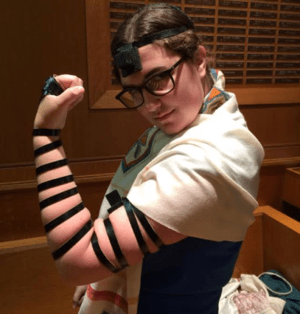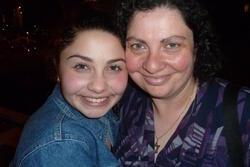Binding My Religious and Feminist Identities Together
I started wearing tefillin at camp. I was fourteen and I had a lot of ideas about overthrowing patriarchal Judaism, and I thought it looked cool. Tefillin are traditionally worn only by Jewish men who have reached bar mitzvah age (thirteen), although Conservative and Reform Judaism, some of the more liberal sects of Judaism, are very accepting of women wrapping as well. I had been watching my male camp counselors wrap every morning for several summers, and now that I was past my bat mitzvah, I wanted to wrap tefillin during morning t’fillot (prayers) at camp too. My synagogue happily found me an old pair in a drawer, and I was off.
I didn’t want to embarrass myself, so the week before camp started, I practiced wrapping obsessively, trying to keep the seven loops from falling down my arm and memorizing the correct way to form a shin, dalet, and yud (the letters that spell one of G-d’s names) in black leather on my hand. I felt pretty confident about my skills by the time I got up to camp. I knew that most of the other girls in my age group didn’t wrap, and I was fine with sticking out. I was going to be that girl in morning minyan. The patriarchy would fall at my feet.
Of course, nobody really cared. My camp is Conservative, and the packing list always proudly proclaims that girls are welcome to bring their own tallit and tefillin. Two of my best friends also wrapped that year, and so did one of our female counselors. But my goal was to make a statement. I took no notice of the brightly colored poster on the wall outlining the different prayers to recite as you moved through the multiple steps of wrapping correctly. For me, tefillin were about feminism, not religion.
Flash forward two summers later. My edah (age group) has just arrived in Pittsburgh at the end of the first leg of our ten-day trip across the country. We’re staying in an Orthodox synagogue for the night. Because we’re told to be respectful of this other community, us girls quietly file into the benches behind the mechitzah for the minyan the next morning. It’s still a service, though, so I ask my counselor if I can pull out my tallit and tefillin (women usually do not wrap in the Orthodox tradition). She shrugs. I decide to go for it; my two friends who also wrap join me.
I thought that wrapping tefillin behind a mechitzah would be the most powerfully feminist thing I could do in an Orthodox synagogue. In many communities, Orthodox women are extremely restricted in how they’re allowed to participate in synagogue life; very few are allowed to lead services, read from the Torah, or wear tallit and tefillin. My friends and I were breaking the rules from behind the barrier, and I fully expected the men of the Pittsburgh synagogue to grow angry when they saw us, maybe even to have demanded that our counselors tell us to take our tefillin off. Instead, they looked at us for a little longer than was maybe polite, turned around, and started davening(praying).
I was stunned, to say the least. What did my wearing tefillin mean if it didn’t provoke the men in this setting? What did it mean that wearing tefillin wasn’t a feminist act in this patriarchal space? I spent the rest of the service thinking about why I had even bothered to wrap.
On the bus ride to Cincinnati later that morning, I realized that tefillin didn’t have to only have feminist connotations for me. The men back in the Orthodox synagogue were clearly a little surprised to see a woman wearing tefillin, but maybe they saw it as me expressing my commitment to Judaism, not to feminism, and they decided to respect that. Tefillin are worn to satisfy the commandment that we should bind the words of the Shema as a sign upon our hands and as a reminder between our eyes. At the most basic level, tefillin have no political activist value attached to them; they’re religious garb. I should wear them to express my commitment to Judaism, not to feminism (I’ve got t-shirts for that bit).
I soon resolved that I would learn more about the prayers you’re supposed to say as you wrap, and therefore connect more with the religious aspects of wrapping. That way my tefillin could be a symbol of both my religious and feminist worldviews.
I don’t feel that I’m sacrificing anything with my new focus on the Jewish meaning behind my tefillin. When I wrap now, I wrap with both my religious and feminist identities in mind. With each twist of the leather around my arm, I bind myself closer to my god, my people, my history, and my feminism.
This piece was written as part of JWA’s Rising Voices Fellowship.








You can be both and that's wonderful.
If you don’t like the patriarchal aspect of your religion, you should start your own. You have no right to change Judaism
Looks like God had his way with you, and he won. Amen
The shel rosh is too low.